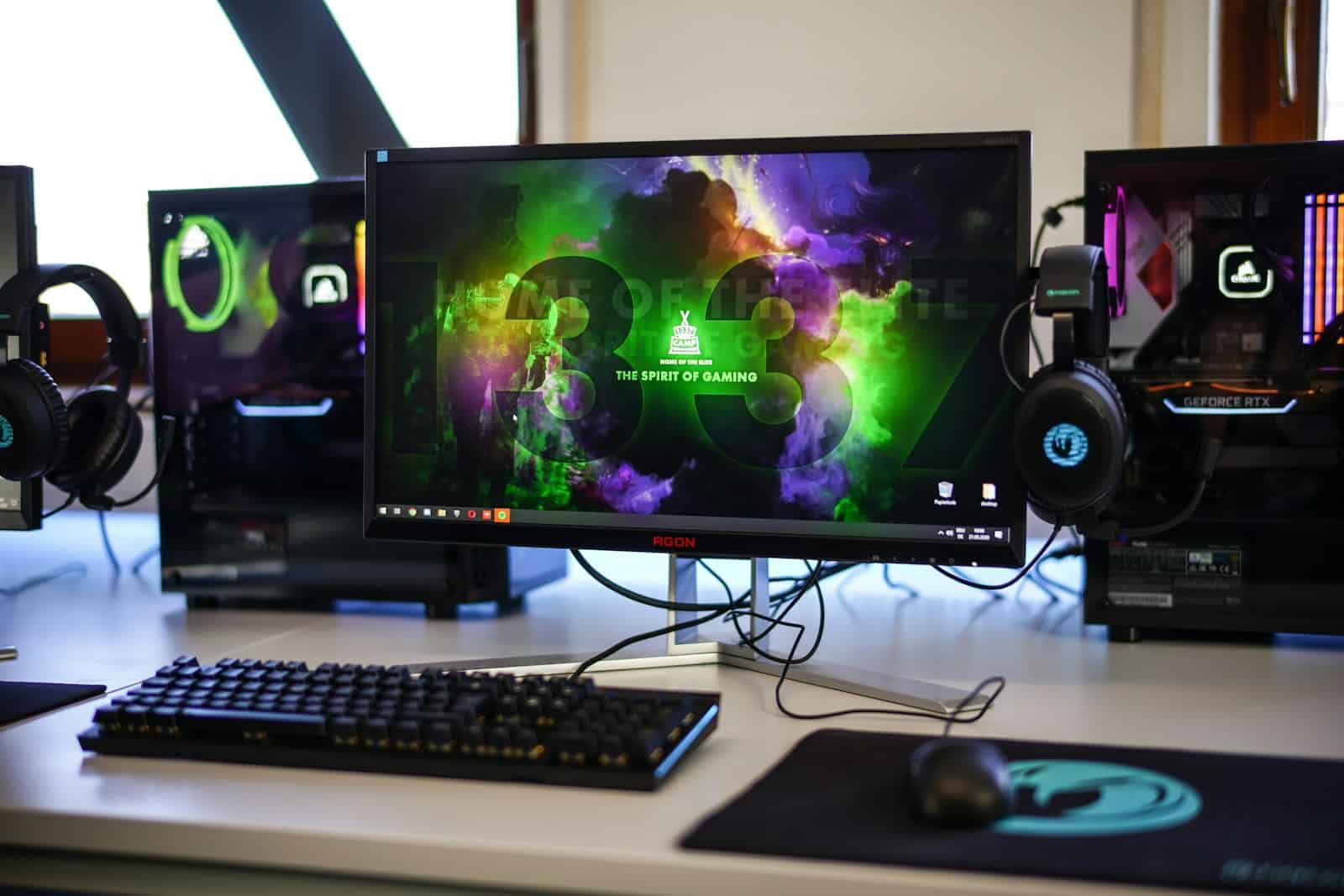Ever wondered how many frames your game is showing each second? Knowing your frames per second (FPS) helps you understand if your game is running smoothly. You can check your FPS through built-in game options, platform overlays like Steam, or by using Windows Game Bar by pressing Win+G.
Many games today come with their own FPS counters tucked away in the settings menu. If your game doesn’t have this feature, don’t worry. Steam users can enable an FPS counter by going to Steam > Settings > In-Game and turning on the overlay. For those with Nvidia graphics cards, GeForce Experience includes an FPS display option in its overlay.
Not using Steam or GeForce? Windows 10 and 11 users can press Win+G to open Game Bar and click the Performance icon to see FPS stats. For more detailed monitoring, third-party apps like MSI Afterburner give you comprehensive performance data while you play. Checking your FPS is the first step to making your games run better.
Ways to Display FPS in Games
Seeing your frames per second (FPS) helps you measure how smoothly your game is running. Whether you’re tweaking settings to improve performance or just want to monitor your system’s output, there are a number of ways to see your FPS. Below are the most reliable methods across Windows, consoles, and specific launchers like Steam and Epic Games.
Method 1: Use Built-In Tools (Windows 10/11 Game Bar)
If you’re on Windows 10 or 11, the Xbox Game Bar offers a quick way to see FPS without installing anything extra.
How to Enable:
- Press
Win + Gto open Xbox Game Bar. - Click on the “Performance” widget (bar graph icon).
- If FPS isn’t shown, click the settings gear and enable FPS monitoring.
- Follow the prompt to grant background access if it appears.
- Once enabled, you’ll see real-time FPS over your game.
Pros:
- No extra software needed
- Shows CPU, GPU, RAM, and FPS all in one
Cons:
- Can be buggy in fullscreen games
- Doesn’t always work with older titles
Method 2: Show FPS in Steam Games
Steam has a built-in FPS counter you can turn on easily.
How to Enable:
- Open Steam.
- Go to
Settings > In-Game. - Under “In-game FPS counter,” pick your display corner.
- You can also toggle “High contrast color” for better visibility.
| Setting | Description |
|---|---|
| Location | Top-left, top-right, bottom-left, bottom-right |
| Contrast | Optional bold font color for better visibility |
This setting works for all Steam-launched games, regardless of genre or engine.
Method 3: NVIDIA GeForce Experience (For NVIDIA GPU Users)
NVIDIA users can use GeForce Experience to track FPS along with other system metrics.
How to Enable:
- Launch GeForce Experience and log in.
- Click the gear icon (Settings).
- Go to “HUD Layout” under the “General” tab.
- Select FPS and choose screen position.
Bonus: You can also record gameplay, monitor temperatures, and check latency from the same overlay.
Method 4: Use Third-Party Software
There are plenty of free tools specifically designed for performance monitoring. These work across all games and platforms:
| Tool | Key Features | Notes |
|---|---|---|
| MSI Afterburner | Highly customizable, overlays for FPS, GPU temp, CPU usage | Requires setup but very powerful |
| Razer Cortex | Lightweight FPS overlay + performance booster | Focuses on freeing up RAM |
| Fraps | Classic tool for benchmarking and screenshots | Limited support for modern DX12/Vulkan |
| RTSS (RivaTuner Statistics Server) | Advanced FPS overlay with frame time graphs | Often used with MSI Afterburner |
These tools let you dive deeper into frame pacing, hardware load, and thermal performance.
Method 5: In-Game FPS Counters
Many games—especially competitive ones—include a built-in FPS counter.
Examples:
- Fortnite: Settings > Video > Show FPS = On
- Call of Duty: Settings > Interface > Telemetry
- Valorant: Settings > Video > Stats > Client FPS
- CS2 (Console): Type
cl_showfps 1or use the Net Graph (net_graph 1)
Always check your game’s video or display settings menu first before downloading any third-party software.
Method 6: Epic Games Launcher
The Epic Games Launcher also includes a native FPS display option.
How to Enable:
- Open the launcher.
- Click on your profile icon > Settings.
- Scroll down to “Manage Games” > Enable FPS for supported titles.
Note: This feature only works with games launched through Epic and may not appear for all titles.
🧮 What FPS Should You Aim For?
| FPS Target | Experience | Ideal For |
|---|---|---|
| 30 FPS | Playable but sluggish | Cinematic or slow-paced games |
| 60 FPS | Smooth and responsive | General gaming |
| 120+ FPS | Ultra-responsive and fluid | Competitive shooters, esports |
| 144+ FPS | For high-refresh monitors | Professional gaming setups |
Adjust your game’s resolution, shadows, post-processing, and anti-aliasing settings to boost FPS if needed.
Key Takeaways
- Most games and platforms offer built-in FPS counters that can be enabled through settings menus.
- Windows users can quickly check FPS using Game Bar (Win+G) without installing additional software.
- Third-party tools like MSI Afterburner provide more detailed performance monitoring beyond basic FPS counting.
Understanding FPS in Gaming
FPS (frames per second) measures how smoothly your game runs. It counts the number of images your computer can display each second while you play.
The Role of FPS in Game Performance
Frame rate directly impacts how well your game performs. Most modern games aim for at least 30 FPS to be playable, but competitive gamers often prefer 60 FPS or higher. When your FPS drops too low, games become choppy and difficult to control.
Different games have different FPS requirements. Fast-paced action games and first-person shooters benefit from higher frame rates, while strategy games might be playable at lower FPS.
Your hardware determines what frame rates you can achieve. The graphics card (GPU) and processor (CPU) work together to render each frame. When either component gets overloaded, your FPS will drop.
Common FPS ranges:
- Below 30 FPS: May feel sluggish
- 30-60 FPS: Smooth for casual gaming
- 60+ FPS: Ideal for most games
- 144+ FPS: For competitive gaming
How FPS Influences Gaming Experience
Frame rate significantly affects how you experience games. Higher FPS creates smoother animations and more responsive controls. This improvement is especially noticeable in fast-paced games where split-second decisions matter.
Low or inconsistent frame rates can cause stuttering that breaks immersion. When frames drop during intense moments, it becomes frustrating and can lead to missed shots or wrong moves.
Input lag also decreases with higher frame rates. The time between pressing a button and seeing the action on screen becomes shorter, giving players a competitive edge.
Many gamers find that once they experience higher frame rates, it’s hard to go back to lower FPS. The difference between 30 FPS and 60 FPS is obvious to most players, while competitive gamers can detect even subtler differences at higher ranges.
Native Methods to View FPS
Many games include built-in ways to check your frames per second without installing extra software. These native methods are often easier to use and don’t add extra strain on your system.
Using In-Game Options for FPS Display
Most modern games include FPS counters in their settings menus. Look for options labeled “Display Performance Stats,” “Show FPS,” or “Performance Overlay” in the video or graphics settings. For example, many Steam games have this feature built right in.
To find these settings:
- Open the game’s main menu
- Look for “Options” or “Settings”
- Check under “Video,” “Display,” or “Graphics” tabs
- Toggle the FPS counter option to “On” or “Show”
Some games place the counter in specific screen corners. You might be able to customize its position and information shown. Games like Fortnite, Valorant, and Overwatch all include native FPS displays that show your frame rate without affecting performance.
Game Console Commands to Check FPS
For games without menu options for FPS counters, you can often use console commands. These are special text commands entered through an in-game developer console.
To use console commands:
- Enable the developer console in game settings if needed
- Open the console (usually with the tilde key
~or F12) - Type the appropriate command
Common FPS console commands include:
cl_showfps 1(Source engine games like Counter-Strike)stat fps(Unreal Engine games)/fps(Many MMOs and Minecraft)
These commands typically display a text overlay showing your current frame rate. The display usually updates in real-time so you can see how different in-game situations affect performance. This method works well for older games that might not have built-in display options in their menus.
Leveraging Operating System Features
Your computer’s operating system offers built-in tools to check game performance without installing extra software. These free options make it easy to see your FPS while playing.
Exploring Windows Game Bar for FPS
Windows Game Bar is a handy tool that comes pre-installed on Windows 10 and 11 computers. To open it while playing a game, press Win+G. Look for the Performance widget, which shows your current FPS.
If you don’t see the Performance widget, click the widgets menu (icon looks like a widget) and select “Performance.” You can pin this widget to keep it visible during gameplay.
Game Bar offers more than just FPS tracking. You can monitor CPU, GPU, and RAM usage too. This helps identify if your computer has performance bottlenecks.
To customize the display, click the settings gear in the Performance widget. You can choose which stats to show and where they appear on screen.
Utilizing GeForce Experience Overlay
If your computer has an NVIDIA graphics card, GeForce Experience provides a powerful overlay for performance monitoring. After installing GeForce Experience, open it and enable the in-game overlay in settings.
While playing a game, press Alt+Z to open the overlay menu. Select “Performance” and then “FPS” to enable the counter. You can choose where on screen to display it – typically a corner works best.
The overlay offers different display modes. The basic mode shows just FPS numbers, while advanced options can display graphs, GPU temperature, and usage percentages. For clean gameplay, the minimal FPS-only option works best.
GeForce Experience also lets you take screenshots, record gameplay, and optimize game settings based on your hardware. All these features make it more than just an FPS counter.
Third-Party FPS Monitoring Tools
If you want more features than built-in FPS counters offer, third-party monitoring tools provide detailed insights about your game performance. These programs track not just FPS but also CPU and GPU usage.
Introduction to FPS Monitor Software
Third-party FPS monitors are programs designed to track game performance metrics in real-time. They display information directly on your screen while you play.
Popular options include MSI Afterburner, FRAPS, and NVIDIA GeForce Experience. Each offers different features beyond basic FPS counting.
MSI Afterburner is widely used because it’s free and works with most graphics cards. It shows FPS alongside GPU temperature, usage, and clock speeds.
FRAPS is an older tool that remains reliable. It can record gameplay footage while measuring frame rates. However, the full version costs money.
For newer systems, HWiNFO and RTSS (RivaTuner Statistics Server) work well together. This combination provides detailed performance data with minimal impact on your games.
How to Choose the Right FPS Software
When picking FPS monitoring software, consider what information you need. Basic users might only want frame rates, while tech enthusiasts may prefer detailed hardware stats.
Look at system compatibility first. Some tools work better with NVIDIA cards, while others favor AMD hardware. Check if the software works with your specific games too.
Consider the performance impact. Heavy monitoring tools can lower your FPS by 1-5%. Lightweight options like Steam’s built-in counter have almost no effect.
Free vs. paid is another consideration. Many excellent free options exist, but paid programs often include extra features like video recording or benchmarking tools.
User interface matters too. Some people prefer minimal, transparent counters, while others want detailed graphs and data panels.
Privacy Concerns with Third-Party Tools
Third-party FPS monitors require certain system permissions to function. This raises important privacy questions about what data they collect.
Some programs only read hardware information locally, while others might send anonymous usage data to developers. Always check the privacy policy before installing any monitoring software.
Reputable tools like MSI Afterburner and HWiNFO are generally safe. They focus on hardware monitoring rather than collecting personal data.
Be cautious with unknown or new FPS monitoring programs. They could potentially access more information than necessary or even contain malware.
If privacy is a major concern, stick to official tools from trusted companies like NVIDIA, AMD, or Steam. These often have clear data policies and limited collection practices.
Optimizing Your Setup for Better FPS
Getting better frame rates requires adjustments to both hardware and software. By making strategic changes, you can significantly boost your gaming performance without spending a fortune.
Hardware Upgrades to Improve FPS
Upgrading your PC components can make a big difference in game performance. The graphics card (GPU) is usually the most important part for better FPS. If your budget allows, a newer GPU can provide immediate improvements.
RAM is another critical component. Having at least 16GB helps modern games run smoothly. Adding more RAM can prevent stuttering in memory-intensive games.
Your CPU matters too. While not always the main FPS bottleneck, an outdated processor can hold back your graphics card. Check if your CPU usage hits 100% while gaming – if so, it might be time for an upgrade.
Storage can also affect performance. Moving games from a traditional hard drive to an SSD won’t directly improve FPS, but it will reduce loading times and may help with texture streaming.
In-Game Settings Adjustments
Tweaking in-game settings offers the quickest way to boost FPS without spending money. Start by lowering resolution – this significantly reduces the number of pixels your GPU must process.
Graphics presets provide easy optimization. Try moving from Ultra to High or Medium settings to see major FPS gains with minimal visual impact.
Settings that impact FPS the most:
- Shadow quality
- Render distance
- Anti-aliasing
- Texture quality
- Particle effects
Use MSI Afterburner or your game’s built-in counter to check FPS after each change. This helps identify which settings affect performance most in your specific game.
Consider turning off V-Sync if you don’t mind screen tearing, as it can limit your frame rate to your monitor’s refresh rate.
Graphics Driver Updates and FPS Impact
Keeping graphics drivers updated is crucial for optimal performance. GPU manufacturers regularly release new drivers that improve game compatibility and performance.
For NVIDIA cards, use GeForce Experience to find the latest drivers. AMD users should check Radeon Software. Both tools can automatically optimize game settings based on your hardware.
Driver updates often include game-specific optimizations that can boost FPS in newer titles by 5-15%. This is especially true right after a popular game’s release.
Be careful with beta drivers. While they might offer early performance improvements, they can sometimes cause stability issues. Stick to official releases if stability is more important than cutting-edge performance.
Remember to perform a clean installation when updating drivers to avoid conflicts with previous versions. This ensures you get the full performance benefit from the update.
Frequently Asked Questions
Many games and apps offer ways to check your FPS (frames per second) while playing. Here are answers to common questions about monitoring your game performance.
What methods are there to monitor FPS on Windows 10 while gaming?
Windows 10 offers several ways to check your FPS. The Xbox Game Bar is built into Windows and shows FPS with a simple keyboard shortcut (Windows key + G).
Steam has its own FPS counter in its overlay. To use it, open Steam, go to Settings, click In-Game, and choose where you want the counter to appear on your screen.
Many games also have built-in FPS displays in their settings menus. Check your game’s video or graphics options to see if this feature exists.
How can I display the FPS counter using NVIDIA’s GeForce Experience?
NVIDIA’s GeForce Experience makes it easy to monitor FPS. First, make sure GeForce Experience is installed on your computer.
Open GeForce Experience and sign in to your account. Press Alt+Z to open the overlay. Click on “Settings” and then “HUD Layout.”
Select “Performance” and turn on the FPS counter. You can choose where on the screen you want the counter to appear.
Is there a way to see FPS statistics on an Xbox during gameplay?
Xbox doesn’t have a built-in FPS counter that works across all games. Some individual games on Xbox include their own FPS display in their settings.
The Xbox also has a “Performance Mode” in newer models like Series X/S. While this mode aims to maximize frame rates, it doesn’t show the actual FPS number on screen.
For accurate FPS measurements on Xbox, you would need external hardware like a capture card connected to a PC with monitoring software.
What are the steps to activate the FPS counter in MSI Afterburner?
MSI Afterburner is a popular tool for monitoring game performance. Download and install MSI Afterburner from the official website.
Open MSI Afterburner and click on the Settings icon. Go to the “Monitoring” tab and find “Framerate” in the list. Check the box next to it and also check “Show in On-Screen Display.”
Press “Apply” and “OK” to save your settings. The FPS counter will now appear when you play games.
How can I check my FPS in Windows 11 while playing a game?
Windows 11 includes the Xbox Game Bar just like Windows 10. Press Windows key + G to open it, then click on the Performance widget and select the FPS tab.
If you need to enable the FPS counter for the first time, click “Request access” and follow the instructions. The counter will then show your current frame rate during gameplay.
Third-party programs like MSI Afterburner, FRAPS, or Rivatuner Statistics Server also work well on Windows 11 for more detailed FPS monitoring.
What options are available to view real-time PC performance, including FPS?
For complete PC performance monitoring, several tools show more than just FPS. MSI Afterburner displays FPS, GPU and CPU usage, temperatures, and memory usage.
HWiNFO combined with Rivatuner Statistics Server provides extensive system monitoring. It tracks virtually every aspect of your PC while gaming.
NZXT CAM offers a clean interface that shows FPS along with CPU, GPU, RAM usage, and temperatures in an easy-to-read overlay during gameplay.







